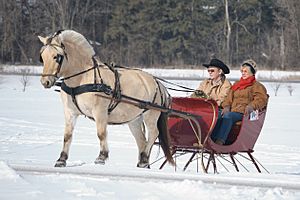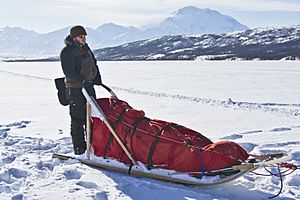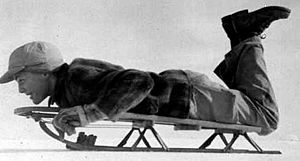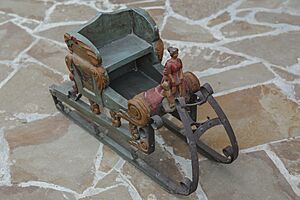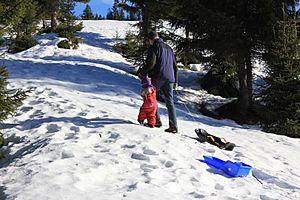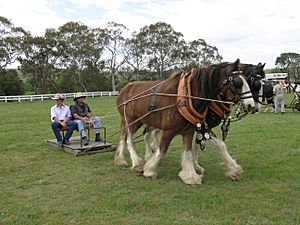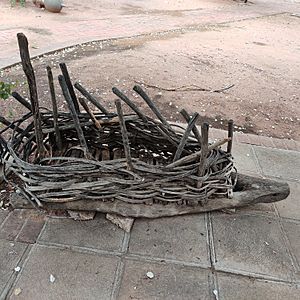Sled facts for kids
A sled, sledge, or sleigh is a vehicle that slides over surfaces like ice or snow. It's built with a smooth bottom or has a body on two or more long, narrow runners. These runners work like skis, helping the sled move easily by reducing friction.
Sleds are used for different things. Some help carry people or goods across flat land. Others are made for fun, like sliding downhill, especially for kids. There are also sleds used in competitions. The words "sled," "sledge," and "sleigh" can mean slightly different things depending on where you are and how they've been used over time.
In British English, sledge is the most common word. A Toboggan is a type of sledge without runners. A sleigh is usually a bigger vehicle, often pulled by horses, dogs, or reindeer, used for carrying people or goods.
In American English, sled is the general term, often meaning a smaller, fun device. Sledge usually means a heavier sled for moving big things. A sleigh is like a carriage for cold weather, with seats for passengers. What's called a dog-sleigh in Britain is a dog-sled in North America.
In Australian English, where there isn't much snow, both sleigh and sledge are used equally.
Contents
What's in a Name?
The word sled comes from an old English word, sledde. This word came from a Dutch word meaning "sliding." The words sleigh and sledge share the same roots. The word sleigh came to English from Dutch people who moved to North America.
How Sleds Work
Sleds are super useful in winter. They can also be pulled over wet fields, muddy roads, or even hard ground. You can make them slide better by putting oil or water on their runners.
Sleds slide with very little friction on ice, icy snow, and wet or dry snow. This means they can go really fast with less effort on these surfaces.
Many types of sleds are pulled by animals. These animals include reindeer, horses, mules, oxen, or dogs.
Sleds Through History
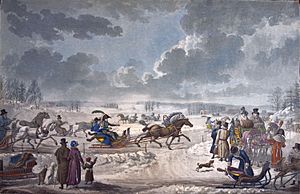
People in Ancient Egypt likely used sledges a lot. They might have used them to move huge obelisks over sand when building their amazing structures.
Sleds were found in the Oseberg "Viking" ship excavation. Sledges were also special because, unlike vehicles with wheels, you didn't have to pay tolls to use them.
Until the late 1800s, a closed winter sled called a vozok was a fast way to travel across the snowy lands of Russia. Kings, bishops, and noble families often used them. Some old royal vozoks are still kept in the Kremlin Armoury.
In the 1800s and early 1900s, explorers in the Arctic and Antarctic often pulled their sledges by hand. But others, like Roald Amundsen, used Dog sleds.
Modern Sleds Today
Transport Sleds
Some transport sleds used to be pulled by animals. Now, they are often pulled by engines, like snowmobiles or tractors. Some are still pulled by people.
- A "motor sled" is another name for a snowmobile.
- The Inuit qamutiik is a special sled made for traveling on sea ice.
- The pulk (or ahkio) is a traditional sled from the Lapland area. It's used for expeditions, mountain rescue, and by military groups in cold weather to carry gear, supplies, and people.
- A Rescue toboggan was developed from the pulk.
- A Stone boat is a farm vehicle. It's used for moving heavy things like rocks or hay bales and can be pulled by a tractor.
Today, some explorers even use kites to pull their sleds!
Fun Sleds
There are many types of sleds made for sliding down snowy hills:
- Toboggan: A long sled without runners, often made of wood or plastic.
- Saucer: A round sled shaped like a saucer, also without runners, usually made of plastic or metal.
- Flexible Flyer: A wooden sled with thin metal runners that you can steer.
- Kicksled: A sled powered by a person kicking the ground.
- Inflatable sled or tube: A plastic tube filled with air, making a very light sled.
- Foam slider: A flat piece of strong foam with handles and a smooth bottom.
- Backcountry sled: A deep, steerable plastic sled with pads and a seat belt, designed for kneeling.
- Airboard: An inflatable single-person sled, like a snow bodyboard.
Competition Sleds
Some sleds are made just for sports:
- Bobsled: A fast, aerodynamic vehicle on lightweight runners. Teams push it and then jump in to slide down an icy track.
- Luge: A tiny one or two-person sled with runners. Riders lie on their backs, feet first, going down an icy track.
- Skeleton: A tiny one or two-person sled with runners. Riders lie on their stomachs, head first, going down an icy track.
Other Sleds
- A cutter is a light, open, horse-drawn sleigh. It usually holds only two people. It became popular in the United States around 1800. These sleds were often very fancy. Around 1920, cutter racing started in the American Rocky Mountains.
- A Troika is a traditional Russian vehicle pulled by three horses. It's usually a sled, but it can also be a wheeled carriage.
- A sled or "stone boat" is used in truck and tractor pulling and horse pulling competitions. It's a flat sled that can carry more and more weight. This helps to find out the maximum load an animal or machine can pull.
Sports Using Sleds
See also
 In Spanish: Trineo para niños
In Spanish: Trineo para niños


